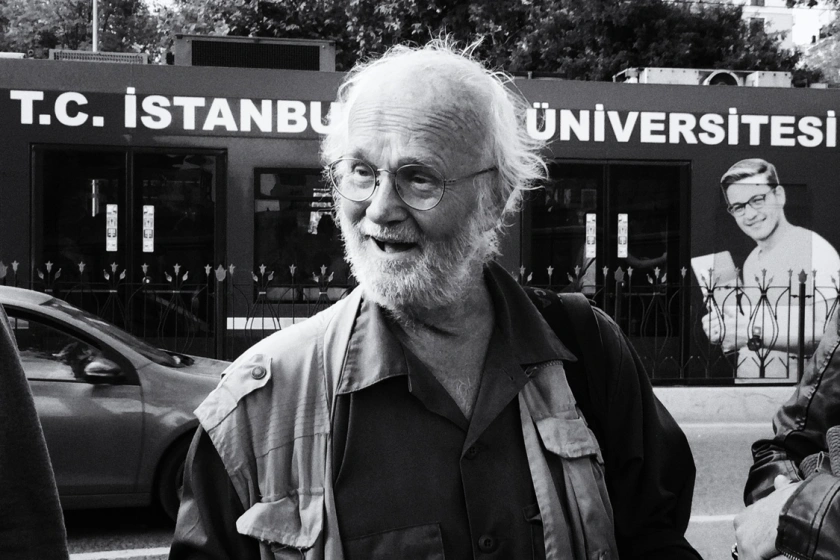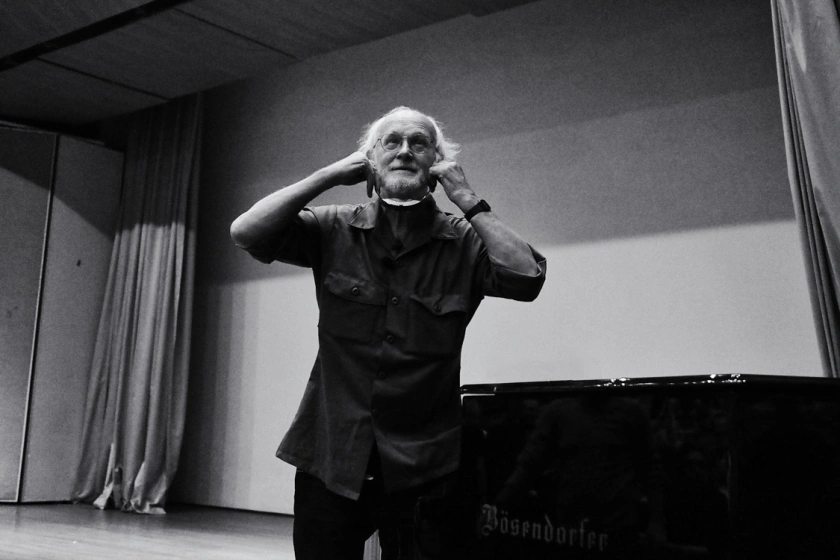
Fotoistanbul 2015
Mimar Sinan Fine Arts University auditorium, Istanbul, Turkey
11 October, 7:30pm
The room is full, and dozens are sitting on the floor because there are no more empty seats. The mythical Josef Koudelka is about to show us his projects, followed by a Q&A session.
To many of us in the room, this talk was the main event of fotoistanbul this year, and we weren’t going to miss it for the world. And then there were a few of us who were still giggling like little kids, remembering our chance encounter with Koudelka on the street the day before.
Picture a bunch of street photographers, walking the streets with our cams, when a man walks to us to ask for directions to the train station. Realizing who he was, we stood there with our mouths open, mumbling like fools. That’s how legendary the man is. We rode the bus with him, each sneaking a few words, a group picture or two, before he finally got rid of us to continue his way. I had taken the opportunity to ask him about his visits to Lebanon shooting the Roman ruins, and he mentioned having spent quite some time photographing Heliopolis in Baalbeck. And then I went awkwardly silent.


Back to our auditorium, below are his answers on the various topics he was asked about during the evening.
Gypsies and Exiles
I photographed “Gypsies” with a 25mm wide-angle lens. I discovered this lens and it really helped me work in these little spaces where gypsies live. After 8 years, and after being totally done with the book Gypsies, I understood how the lens works and how I should use it. But I was starting to repeat myself and I didn’t like – and don’t like – to repeat myself. I wanted change.
So when I left Czechoslovakia a couple of years later, I started working on “Exiles”. But I didn’t work in these little spaces anymore. As a result, the gypsies in “Exiles” are different from those in the first book. I travelled all over to photograph them, but I never knew why. I tried to think about it, to come to certain conclusions, but I couldn’t find an answer.
Magnum and Henri Cartier-Bresson
Some photographers, especially those who left Magnum, don’t speak positively about the agency. I can’t say anything bad about it. To the contrary, thanks to Magnum, I became who I am today. But of course I was very careful to stay true to myself and not to get influenced by certain things.
Henri Cartier-Bresson helped me very much in that area. I met him in 1970 or 1971, and he was of extreme importance to me in helping me avoid the mistakes he did. HCB wasn’t really a reporter; it wasn’t his nature. But Robert Capa moved him in that direction. So the most important thing that HCB could do for me was to help me be who I was, and not fall for the compromises he had to do.
On photographing landscapes
I have been photographing for more than 50 years, and I’m finding fewer and fewer people I want to photograph. This is not to say that people are terrible or that the world is terrible. I’ve seen so many beautiful things in my life, and I’m very happy. But photographing people is very difficult for me now. I really want to be alone. I don’t want to see anybody around me. And I think that only when you’re alone you could start identifying with the landscape around you.
Photography Workshops
Many Magnum photographers are giving workshops and the reason is money. It’s becoming more and more difficult to make money as a photographer, and workshops help in that area. I never gave any workshops and I’m still alive. This doesn’t mean I won’t give any, but I hope I won’t have to.
This is not a criticism of the people who do workshops; not at all. I think it’s very good if the people who have the capacity to teach do so, especially if they like to be around people. I, on the other hand, like to be left alone. You know, after this talk, I’ll probably try to escape as quickly as possible. Don’t get me wrong, it’s a pleasure to be here and you’re all wonderful, but it’s difficult for me.
Wall: Israeli and Palestinian Landscapes
The last project I did, of which you haven’t seen any photos here, was in Israel. I didn’t know anything and didn’t want to know anything about Israel. I generally believe that if I go to a place, and if I look enough, and meet people, then I could understand, not so much through my brain, but through my eyes.
My Magnum colleagues warned me that it’s not easy to photograph there. But I finally went there and I’m very happy I went. After seeing the project, photos of the wall separating the West Bank from Israel, an Israeli poet told me: “Josef, thank you for your photographs, because you made the invisible visible”. He meant that the wall is invisible to Israelis and they don’t want to talk about it.
After having been there 7 times in 4 years, I came to the conclusion that Israel became what it didn’t want to become, and that Palestine has no chance whatsoever.
Turkey
I have been documenting Greek and Roman archaeological ruins in the countries around the Mediterranean. I visited all 20 of these countries twice, luckily including Syria in the period where I was able to do so. And of course I discovered Turkey, and discovered that it’s an archaeological treasure.
I’m preparing a big exhibition for 2017 in the Panthéon in Paris on all this work I did in the Mediterranean. The text for the accompanying book will be written by the director of the Louvre.
Even after all of this is done, I would like to come back to Turkey to continue to work; I’m fascinated by the place you have here.

Very interesting!! We feel your fascination😀😀😀